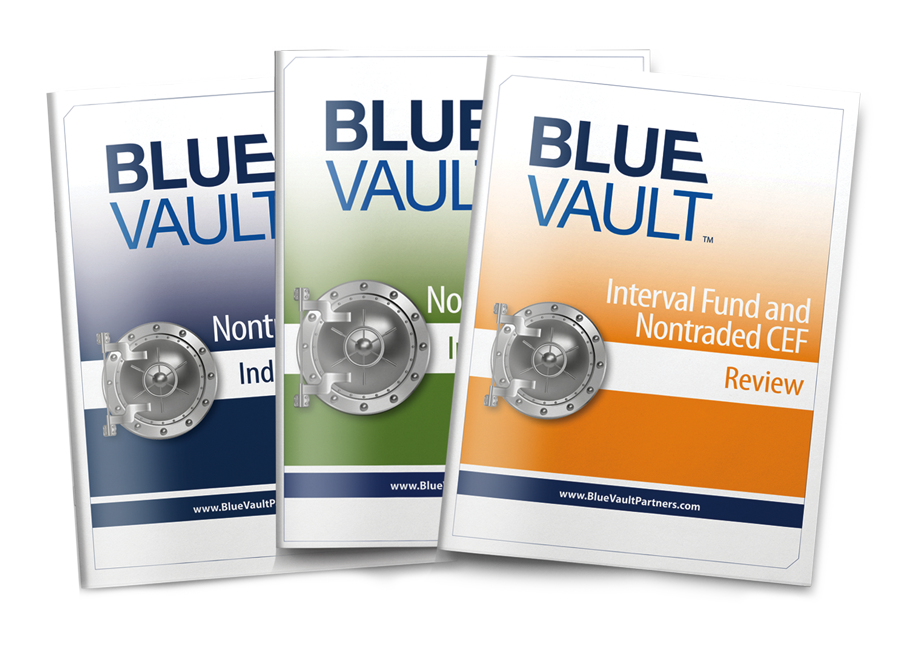LEARN
Common Alts Terms
Cash and Cash Equivalents
Includes both cash and cash equivalents as noted on the balance sheet. Restricted cash items are not included in this category due to certain limitations and restrictions on how these funds may be used.
Correlation
This is calculated as the correlation between the daily or monthly percentage changes in the adjusted NAV and the daily or monthly percentage changes in the S&P 500 closing values. This measures the degree to which the two tend to move together. Correlations can also be computed using the total returns of two assets which include changes in values plus distributions paid over a given period.
Dealer Manager Fees
These are fees paid to the dealer manager from the offering proceeds. Some fund advisors will subsidize dealer-manager fees to different degrees for different share classes.
Debt Maturity
The due date for a debt when the principal must be repaid. The commercial real estate industry has more than $1 trillion in maturing loans coming due in 2025. The challenge is renewing these loans in a time of tight credit and fallen real estate values.
If a fund cannot refinance, it has to divest of assets, which reduces Funds from Operations (FFO) and endangers a payout to investors. If the majority of a fund’s debt is maturing in the next 12-24 months, this could be an issue.
Debt to Total Assets Ratio
The ratio of Total Debt divided by Total Assets. There is no perfect debt level for a fund; some sectors use more debt than others. But what was once considered reasonable debt can become a problem in a difficult economic environment. A careful investor will look at both the Debt-to-Total Assets Ratio and the Interest Coverage Ratio to gauge if a fund is over-leveraged. Also, see the Debt Maturity schedule for any debt refinancing challenges on the horizon.
Distribution/Shareholder Servicing Fees
These fees comprise the “trail” or that portion of the dealer manager fee that is paid over time rather than at the time the shares are sold in the public offering. A Stockholder Servicing Fee may consist of an advisor stockholder servicing fee and a dealer stockholder servicing fee.
Distributions
Distributions paid during the indicated time frame.
DRIP (DRIP Price)
Under the distribution reinvestment program or DRIP, investors may reinvest the distributions paid. Distributions on shares are reinvested into additional shares of the same class. The purchase price per share under the DRIP often will be equal to NAV per share applicable to the class of shares purchased, calculated as of the distribution date. No selling commissions, dealer manager fees or distribution fees will be paid on shares sold under the DRIP at the time of reinvestment, but depending upon the share class, applicable stockholder servicing fees may apply to distributions paid after the shares are issued and held. Life-cycle funds with fixed offering close dates have often sold shares via the DRIP at a 5% discount to the offering prices.
FFO
Funds from Operations. Instead of reporting earnings like other companies, REITs report FFO. Why is this?
REITs have high depreciation expenses because of how properties are accounted for. But the properties don’t fall in value to zero like, say a piece of equipment would. So the high real estate depreciation charges—which are required accounting—can seem unrealistic given that real estate assets have historically appreciated and been sold for a gain. Besides, those depreciation expenses aren’t real cash being expensed anyway. It’s only a paper loss and not a cash loss. So FFO adds back the depreciation expenses—and makes other adjustments as well.
Keep in mind that FFO is a non-GAAP financial measure of REIT performance. GAAP stands for Generally Accepted Accounting Principles. Non-GAAP means that FFO is not an accounting standard.
The National Association of Real Estate Investment Trusts (NAREIT) has defined FFO as:
Net Income
+
Depreciation
-/+
Gains/Losses on Property Sales (removes one-time items)
-/+
Adjustments for unconsolidated joint ventures and partnerships
Unfortunately, the NAREIT definition isn’t uniform in practice. Not every REIT calculates FFO according to the NAREIT definition or they may interpret the NAREIT definition differently.
Blue Vault presents FFO in keeping with the NAREIT definition to the best of its ability, given the public information made available by each REIT in the quarterly filings. We may attempt to deduce FFO for nontraded REITs that are not forthcoming, but cannot guarantee the accuracy.
FFO does have some limitations:
- FFO is an accrual measure of profitability, not a cash measure of profitability. That is because FFO (and net income) records income and expenses, regardless of whether or not cash has actually changed hands.
- The NAREIT definition of FFO also does not take into account one-time items—those gains or losses that are nonrecurring.
- It does not subtract out the capital expenditures required to maintain the existing portfolio of properties. Real estate holdings must be maintained, so FFO is not quite the true residual cash flow remaining after all expenses and expenditures.
FFO is an imperfect measure of REIT performance, but it is one we can use for the nontraded REIT industry at this time. Blue Vault is employing the NAREIT definition and adjusting company-reported FFO to comply with NAREIT whenever possible.
Fixed Rate Debt
Debt that has a fixed interest rate for a set period of time.
Floating Rate Debt
Debt that has a variable rate and moves based on changes in key interest rate indicators such as SOFR, Fed Funds Rate, Prime Rate, Treasury Yields, LIBOR, etc. Many times, the debt is quoted as the indicator plus a spread amount, such as SOFR + 250, which means the active rate would be the current SOFR rate plus 2.50%.
Fund Operating Expense Ratio
This is calculated as the annualized year-to-date total operating expenses (less interest expense) divided by the average equity for the period. This ratio measures operational efficiency and the impact of management fees and administrative expenses on the fund.
GAAP Earnings Payout Ratio
This is calculated as the year-to-date total distributions divided by year-to-date net change in net assets from operations. This metric is designed to determine how much of the distribution is derived from the net change in net assets, or GAAP-related earnings.
Gross Dollars Raised
Sales of shares, including those purchased with reinvested dividends, during the public offering.
Inception Date
The date when each REIT reported the commencement of fundraising activities for the public offering. The commencement date for an initial private offering of securities (if applicable) was not taken into consideration.
Initial Offering Price
The per share purchase price for shares of common stock in a continuous public offering will be the applicable NAV per share for the share class, plus applicable selling commissions and dealer manager fees. Each class of shares may have a different NAV per share because ongoing fees and expenses allocable to each share class differ with respect to each class.
Interest Coverage Ratio
Since it’s tough to gauge how much debt is too much or too little, the Interest Coverage Ratio is another clue to a fund’s debt health. A common method of calculating the ratio is EBITDA/interest expense.
The Interest Coverage Ratio is a measure of a fund’s ability to honor its debt interest payments. A high ratio means that the company is more capable of paying its interest obligations from operating earnings. So even if interest costs increase due to higher costs of borrowing, a high Interest Coverage Ratio shows that a fund can handle those costs without undue hardship.
The analyst community typically looks for an Interest Coverage Ratio of at least two (2)—that is, earnings before interest, taxes, depreciation, and amortization are at least twice interest expenses—to maintain sufficient financial flexibility. That said, an interest-coverage ratio of 1.5 is generally considered the bare minimum level of comfort for any company in any industry.
At minimum, the ratio should be consistent quarter after quarter, year after year. Improving interest coverage is a positive signal of the company’s overall health, and a declining pattern is a danger sign of financial trouble, which may be imminent or far off into the future. However, a declining ratio does not automatically mean difficulty for the company, since a temporary change in operations can result in a blip in earnings.
In general, a very low coverage ratio can indicate higher risk. On the other hand, a very high interest coverage ratio may suggest that the company is missing out on opportunities to expand its earnings through leverage.
Lease Expiration
Date when the lease ends and the landlord will need to re-lease the space.
MFFO
Modified Funds from Operations. Blue Vault’s FFO presentation for each REIT is in accordance with the NAREIT definition to the best of its ability. Both FFO and MFFO have been provided for comparison purposes.
Modified FFO, or MFFO, is a supplemental measure that can vary from REIT to REIT. All REITs are different to some degree from one another, and present their supplemental measurements differently, depending upon their operational activity. MFFO is intended to give a sharper representation of a REIT’s true cash flows, that is, cash flow from operations.
To calculate MFFO, some REITs add back only Acquisition Costs to FFO. That’s because Acquisition Costs arguably penalize REITs in the acquisition phase. Other REITs also add back write-down charges (impairments) or adjust for other one-time charges, since they are not recurring in nature. Still others will include an adjustment for straight-lining rents. So one REIT’s reported MFFO may not be comparable to another REIT’s reported MFFO, yet it is valuable insight into real estate operational performance. The REITs are trying to give a clearer picture of their cash flow given the limitations of FFO. For REITs that do not report MFFO, Blue Vault’s MFFO estimates entail adding back Acquisition Costs to FFO.
AFFO, or Adjusted Funds From Operations, which is also subject to varying methods of computation–is generally equal to the REIT’s Funds From Operations (FFO) with adjustments made for recurring capital expenditures used to maintain the quality of the REIT’s underlying properties. The calculation also includes adjustments for straight-lining rents, leasing costs, and other material factors. One REITs AFFO isn’t necessarily the same as another REIT’s MFFO.
Despite the differences and the variability, both of these non-GAAP metrics are considered a more accurate measure of residual cash flow for shareholders than simple FFO. They provide for a better predictor of the REIT’s future ability to pay dividends. So keep these supplemental measures in mind while reviewing FFO calculations for each REIT.
(See also FFO definition)
NAV
Net asset values for funds are determined by its board of directors based upon third-party valuations of the fund’s assets less the valuations of its liabilities. Typically, the third-party valuation firm estimates the values based upon market data and presents the board of directors with a range of values from which the board chooses an NAV. NAV is not a measure used under generally accepted accounting principles in the U.S. (“GAAP”) and the valuations of and certain adjustments made to assets and liabilities used in the determination of NAV will differ from GAAP. NAV should not be considered to be equivalent to stockholders’ equity or any other GAAP measure.
Payout Ratios (Also Referred to as Distribution Coverage)
How much of a fund’s income from operations (FFO, MFFO, NII, GAAP) is used to pay the distributions. If the Distribution Coverage Ratio is over 100%, then the fund is using money from other sources—outside of income—to pay distributions. Distribution coverage is the reciprocal of the Payout Ratio.
Real Estate Assets
Property, land, and buildings under construction. It also includes investments in other real estate ventures, real estate loans, etc.
Redemptions
Fund shares bought back from the shareholder/investor by the fund under a program referred to as the Share Redemption Program (SRP), to provide investors with a limited form of liquidity. This Program is severely limited in the number of shares that can be repurchased annually. Most funds also have a provision that allows them to suspend this liquidity feature upon Board approval.
Share redemption ratios are provided for comparison purposes only and may not be calculated in the same way each individual fund’s share redemption program guidelines dictate. With that in mind, please refer to the individual fund offering documents for more details. To standardize this metric and make general program comparisons, we calculate redemption ratios by dividing the actual number of shares redeemed by the weighted-average number of shares outstanding each quarter.
Return on Equity
This is calculated as the annualized net change in assets from operations, a line item that includes net investment income, realized gains, and unrealized gains, divided by average equity over the time period. This illustrates the annualized book-value return over the given time period.
Selling Commissions
The portion of the offering price which is paid to broker dealers who sell shares in the public offering. In the prospectus for each offering, the section dealing with the “Use of Proceeds” will typically estimate for both the minimum offering size and the maximum offering size the percentage of the offering that will be paid in selling commissions.
Sharpe Ratio
This is calculated by subtracting the risk-free rate (10-year Treasury yield) from the rate of return on the Adjusted NAV and dividing the result by the annualized standard deviation. This measures the risk-adjusted performance of the fund. The higher the Sharpe Ratio, the better the fund’s risk-adjusted performance.
Standard Deviation
The standard deviation of the daily percentage change in Adjusted NAV measures how much variation from the average occurred during the time period. A lower standard deviation indicates less variation in NAV, and less risk, over the given time period.
Taxable Income Payout Ratio
This is calculated as the year-to-date total distributions divided by estimated year-to-date net taxable income. Net taxable income includes net investment income and realized capital gains. This metric is designed to determine how much of the distribution is derived from taxable income. Beyond the beginning stages of the fund, this ratio should be below or close to 100%.
Total Return
A reported value that shows the performance for the fund over a given period. This is typically calculated using any change in NAV per share along with any distributions paid during the period. A negative value indicates the fund lost value for the investor over the time period.
Waivers as a Percentage of Distributions
This is calculated as the year-to-date total expense support divided by the year-to-date distributions. This measures the percentage of distributions being funded through fee waivers and expense support from the sponsor.
Yield On Equity
This is calculated as the annualized total investment income for the period divided by the average equity for the period. This measures how much income was earned in relation to the total equity.
Yield on Portfolio
This is calculated as the annualized total investment income for the period divided by the average total amount of investments for the period. This measures how much income was earned in relation to total investments.
Upcoming Webinars
The Next Wave of Interval Funds: What Advisors Should Know
- Daniil Shapiro
- | Moderator
- Michael Perini
- | Speaker
- Stacy Chitty
- | Speaker
AUM Growth in a Metals Boom: How RIAs Are Using Gold and Silver Today
Explore
Access Detailed Asset Manager and Offering Information
Become a member to access our detailed reports and get info on sponsor acquisitions, capital raise and financials.





